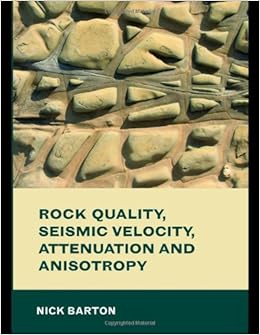
Free Downloads Rock Quality, Seismic Velocity, Attenuation And Anisotropy

Seismic measurements take many forms, and appear to have a universal role in the Earth Sciences. They are the means for most easily and economically interpreting what lies beneath the visible surface. There are huge economic rewards and losses to be made when interpreting the shallow crust or subsurface more, or less accurately, as the case may be. This book describes seismic behaviour at many scales and from numerous fields in geophysics, tectonophysics and rock physics, and from civil, mining and petroleum engineering. Addressing key items for improved understanding of seismic behaviour, it often interprets seismic measurements in rock mechanics terms, with particular attention to the cause of attenuation, its inverse seismic quality, and the anisotropy of fracture compliances and stiffnesses. Reviewed behaviour stretches over ten orders of magnitude, from micro-crack compliance in laboratory tests to cross-continent attenuation. Between these extremes lie seismic investigation of rock joints, boreholes, block tests, dam and bridge foundations, quarry blasting, canal excavations, hydropower and transportation tunnels, machine bored TBM tunnels, sub-sea sediment and mid-ocean ridge measurements, where the emphasis is on velocity-depth-age models. Attenuation of earthquake coda-waves is also treated, including in-well measurements. In the later chapters, there is a general emphasis on deeper, higher stress, larger scale applications of seismic, such as shear-wave splitting for interpreting the attenuation, anisotropy and orientation of permeable 'open' fracture sets in petroleum reservoirs, and the 4D seismic effects of water-flood, oil production and compaction. The dispersive or frequency dependence of most seismic measurements and their dependence on fracture dimensions and fracture density is emphasized. The possibility that shear displacement may be required to explain permeability at depth is quantified. This book is cross-disciplinary, non-mathematical and phenomenological in nature, containing a wealth of figures and a wide review of the literature from many fields in the Earth Sciences. Including a chapter of conclusions and an extensive subject index, it is a unique reference work for professionals, researchers, university teachers and students working in the fields of geophysics, civil, mining and petroleum engineering. It will be particularly relevant to geophysicists, engineering geologists and geologists who are engaged in the interpretation of seismic measurements in rock and petroleum engineering.

Hardcover: 756 pages
Publisher: CRC Press; 1 edition (October 31, 2006)
Language: English
ISBN-10: 0415394414
ISBN-13: 978-0415394413
Product Dimensions: 8.7 x 1.6 x 11.1 inches
Shipping Weight: 5.1 pounds (View shipping rates and policies)
Average Customer Review: 5.0 out of 5 stars See all reviews (2 customer reviews)
Best Sellers Rank: #2,663,162 in Books (See Top 100 in Books) #107 in Books > Engineering & Transportation > Engineering > Civil & Environmental > Seismic Design #369 in Books > Science & Math > Earth Sciences > Seismology #531 in Books > Science & Math > Earth Sciences > Earthquakes & Volcanoes

This encyclopedic monograph expresses nearly 40 years of Nick Barton's research interests in engineering classification of rock masses. Rock Quality, Seismic Velocity, Attenuation, and Anisotropis organized into two basic parts: Chapters 1 through 9 in Part I pertain to civil engineering scales and applications, whereas Chapters 10 through 16 in Part II pertain to large-scale seismic phenomena and high pressure laboratory rock physics tests. Figures outnumber equations through Rock Quality,Seismic Velocity, Attenuation, and Anisotropy, and a random examination revealed at least two figures on just about any pair of facing pages. References for all chapters are combined into a single list that is 27 pages long. Conclusions are given for each chapter in numbered paragraphs. The largest number of paragraphs (51) is for Chapter 15 (Shear wave splitting in fractured reservoirs and resulting from earthquakes). The Index is impressive, occupying 64 pages. Rock Quality, Seismic Velocity, Attenuation, and Anisotropy contains so much valuable information that selecting one or two items to serve as examples is a challenge.The introduction to Rock Quality, Seismic Velocity, Attenuation, and Anisotropy includes comments regarding the different problems that civil engineers and engineering geologists face compared to problems that petroleum engineers or tectonophysicists face. Barton notes that it is understandable, but regrettable, that advances in the different areas have been largely unknown outside the boundaries of the technical area. Practitioners and researchers in these major fields participate in separate conferences and read and publish in separate journals. Barton notes that technical language complicates cross-discipline interactions.
Rock Quality, Seismic Velocity, Attenuation and Anisotropy Rock Climbing Smith Rock State Park: A Comprehensive Guide To More Than 1,800 Routes (Regional Rock Climbing Series) Poor-Quality Cost: Implementing, Understanding, and Using the Cost of Poor Quality (Quality and Reliability) You Shall Know Our Velocity Properties of Materials: Anisotropy, Symmetry, Structure ASD/LRFD Wind and Seismic: Special Design Provisions for Wind and Seismic with Commentary (2008) Seismic Stratigraphy, Basin Analysis and Reservoir Characterisation (Handbook of Geophysical Exploration: Seismic Exploration) Seismic Loads: Guide to the Seismic Load Provisions of ASCE 7 - 10 Seismic Loads: Guide to the Seismic Load Provisions of ASCE 7-05 Quantitative Seismic Interpretation: Applying Rock Physics Tools to Reduce Interpretation Risk The Illustrated Practical Guide to Water & Rock Gardening: Everything You Need To Know To Design, Construct And Plant Up A Rock Or Water Garden With Directories Of Suitable Plants And How To Grow Them All Music Guide to Rock: The Definitive Guide to Rock, Pop, and Soul (3rd Edition) Rock Climbing Virginia, West Virginia, and Maryland (State Rock Climbing Series) Rock Climbing Virginia, West Virginia, and Maryland, 2nd (State Rock Climbing Series) Classic Rock Fake Book: Over 250 Great Songs of the Rock Era, Arranged for Piano, Vocal, Guitar, Electronic Keyboard an all 'C' Instruments Rock Climbing Joshua Tree West: Quail Springs To Hidden Valley Campground (Regional Rock Climbing Series) Rock Climbing the San Francisco Bay Area (Regional Rock Climbing Series) Rock Climbing Montana (Regional Rock Climbing Series) Rock Climbing Connecticut (State Rock Climbing Series) Juran's Quality Planning and Analysis for Enterprise Quality (McGraw-Hill Series in Industrial Engineering and Management)



